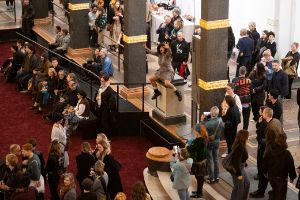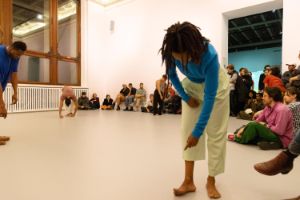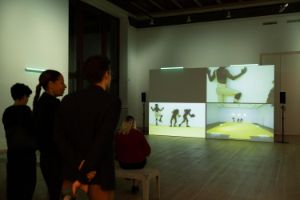Exhibition Texts
Introduction
“Choreography is the movement of ideas
across bodies. A political act; a writing against
racist forms of erasure and misrecognition.”
— Ligia Lewis
In Ligia Lewis’ performances and films, comedy and tragedy collide. As an artist and choreographer, she playfully weaves together narratives of race, gender, violence and resistance to unravel how these histories continue to haunt and define the present. Collapsing historical timelines, Lewis’ works emphasise the recurring cycles of racialised violence. Her films and performances suggest that history is carried within the body, passed down through multiple generations and their lived experiences. Using voice, text and charged facial expressions, Lewis creates multi-layered works that challenge how we see each other. In addition to her embodied practice, a rich theoretical and political curiosity forms the basis of Lewis’ thinking. For her, the concept of “study” is a reflective practice grounded in action, in dialogue with a chorus of voices. Floating across the exhibition spaces, a selection of books invite you to engage further with some of the many ideas that anchor Lewis’ works.
Wayward Chant
2025
Sound, light, performative activations
Live performances: 28.11. and 29.11., 20:00
What does it mean to dance
for the dead, I mean the not
living, I mean the not not living,
I mean the not living yet.
In Wayward Chant, a chorus explores the intersections of sound and movement as figures appear and disappear within a fleeting choreography. By playfully using the architecture of the atrium to cast shadows, Lewis draws attention to what remains in the dark. How, and under what conditions, can we truly see and recognise one another? The choreography of moving, chanting bodies resembles a hummed hymn, performed in delay. Early Western church music intertwines with blues-like melodic and harmonic details, serving as a vivid reminder of a lingering past. Vocal incantation meets a visually stark space, haunted by feelings of alienation, collective uncertainty and the power of assembly. Over the course of the exhibition, Wayward Chant unfolds iteratively and seemingly in passing, accumulating into an evening-length work on 28 and 29 November, premiering as part of the Performing Arts Season.
Ligia Lewis – Concept, Choreography, Artistic Direction, Text
George Lewis Jr. aka Twin Shadow, Wynne Bennett – Original Musical Composition
Moritz Freudenberg, Ligia Lewis – Video
Sandra Blatterer, Joseph Wegmann – Lighting Design
Boglárka Börcsök – Outside Eye
Godlive Lawani - Stane Performing Arts Management – Production Management
SADAK – Costume Design
Neda Sanai – Sound Design
Performers
Navild Acosta, La Uyi Ihasee, Justin Francis Kennedy, Nasheeka Nedsreal, Cíntia Rangel, Corey Scott-Gilbert, Nima Aida Séne

Ligia Lewis, Wayward Chant, live performance, Ligia Lewis: I’M NOT HERE FORRRRR…, Gropius Bau, 2025
© Gropius Bau, photo: Rosa Merk
A Plot, A Scandal

Liga Lewis, A Plot, A Scandal, installation view, Ligia Lewis: I’M NOT HERE FORRRRR…, Gropius Bau, 2025
© Gropius Bau, photo: Rosa Merk
Some stories are hard to tell.
Lucky for us, ghosts don’t die
so easily.
A plot is a word with many possible meanings: a story or narrative, a piece of land or property and the act of scheming or plotting. In A Plot, A Scandal, a series of disparate plots are woven together as a form of resistance and embodied memory. The film departs from 17th-century philosopher John Locke’s doctrine on (white) man’s natural rights to life, liberty and property, which later informed the U.S. Declaration of Independence. As of late, it is understood that Locke personally benefited from the trade of enslaved people through his investments in the Royal African Company. As a response, Lewis turns to a series of plots enacted across the Caribbean that act as forms of resistance. These include Maria Olofa (Wolofa)’s leading role in uprisings in 16th-century Dominican Republic; Cuban artist and revolutionary José Aponte’s attempt at organised rebellion in the 19th century; and – what Lewis considers a minor rebellion – her own great-grandmother’s resistance through her spiritual practice of Afro-Dominican Palo, performed at a time of anti-Black governance.
Ligia Lewis – Concept, Screenplay, Artistic Direction
George Lewis Jr. aka Twin Shadow, Wynne Bennett – Scores
Moritz Freudenberg – Director of Photography
Dragana Jovanović – Editing
Commissioned by the Center for Art, Research and Alliances (CARA)
Performers
Ligia Lewis, Corey Scott-Gilbert
Water Will (in Melody)
2018/2025
Sound, light
TO WILL IS TO WAY
MY WILL IS WILLFUL
MY WILL IS WAYWARD
Set in a cavernous sonic landscape, Water Will (in Melody) uses the cave as a metaphor through which the “feminine” can be explored. She focuses on how the speech of the “femme” is culturally (mis)understood. The work departs from the Brothers Grimm’s 19th-century tale The Willful Child, which tells the story of a stubborn child whose disobedience leads to their death and eventual haunting. As a female-presenting or non-white person, to “be identified as willful is to become a problem”, writes feminist theorist and scholar Sara Ahmed. Building on Ahmed’s thoughts, Lewis points to how agency is restricted by racialisation, rendering “willfulness” illegible, particularly for Black femmes. The exhibition room is set with a score of voices unleashed in their willfulness. Speech breaks down, stumbles, gurgles and gets swallowed, mixed with a chopped and remixed version of Sergei Rachmaninoff’s Isle of the Dead (1909). The voices of Lewis’ cast – which includes artist and actress Susanne Sachsse, choreographer and performer Dani Brown and Lewis herself – create a sonic landscape of horror.
Ligia Lewis – Concept, Artistic Direction
Edmund Burke, The Brothers Grimm, Ligia Lewis – Texts
Max Eilbacher– Sound design
Dani Brown, Ligia Lewis, Susanne Sachsse – Voices
Sergei Rachmaninow, Isle of Dead, 1909 – Music
study now steady

Ligia Lewis, study now steady, live installation view, Liga Lewis: I’M NOT HERE FORRRRR…, Gropius Bau, 2025
© Gropius Bau, photo: Rosa Merk
2023
Live performance, sound, 45 min loop with 15 min break
Live performances: Thursday–Monday, 14:00–17:00
Me seeing you seeing me
seeing you seeing me.
The live installation study now steady turns the exhibition space into a studio for ongoing choreographic study. From Thursday to Monday, a group of dancers perform scores by Lewis as a durational process. These scores have shaped many of Lewis’ stage and film works. To be “in study” points to the unfinished work of liberation. Black Studies scholars Fred Moten and Stefano Harney describe “study” as an embodied way of being, thinking and learning together – outside and against institutional frameworks such as universities and museums. study now steady renders visible threads of Lewis’ processcentred artistic practice and emphasises the notion that life is a state of constant rehearsal. In a shared space with the audience, the studies unfold through the interplay of bodies and the surrounding architecture. The performers come together in constellations of temporary community and shifting relationalities.
Ligia Lewis – Concept and Scores
Commissioned by the Center for Art, Research and Alliances (CARA)
Performers
Navild Acosta, Boglárka Börcsök, Juan Pablo Cámara, Michelle Cheung, Emil Maria Ertl, Miguel Guzman, Fedra Morini, Samuel Pereira, Cíntia Rangel, Corey Scott-Gilbert, Elvan Tekin, Karol Tyminski
deader than dead
2020
Video (colour), sound, 19 min, 39 sec
Facts are simply perceptions
and surfaces. You go round
and round and fall straight to
the ground. What it is, FACTS.
Based on an investigation into expressions of humour, including “deadpan” and “corpsing”, deader than dead reflects on Blackness as a political position and anti-Blackness as a structural condition. “Deadpan” describes a type of humour in which the protagonist remains passive and emotionless. The English theatre term “corpsing” refers to an actor involuntarily breaking with their role and character – typically through laughter – and for Lewis, “falling out of representation”. In the film, the performers repeatedly lay flat or “dead”, resisting any narrative development. Their encounters shift between gestures of care and violence. They crash to the ground, their bodies carried and eventually pulled from centre stage. Though there are moments in which the performers are temporarily revived, their frenzied movements end in exhaustion. Whispers and muddled speech are intertwined with Guillaume de Machaut’s medieval lament, a 14th-century choral song, and mixed with techno beats. Along with the sound of the performers’ bodies, they form a contemporary soundtrack for this dance of the dead. Inspired by philosopher David Marriott’s 2016 essay Corpsing; or, The Matter of Black Life, Lewis’ deader than dead reflects on time, the inevitability of death and tragedy’s disproportionate proximity to Black people as a result of racism.
Ligia Lewis – Concept, Scenic Design, Choreography
Ligia Lewis, Steven Wetrich – Editing
Guillaume de Machaut, Complainte: Tels rit au main qui au soir pleure (Le Remède de Fortune), approx. 1340s – Music
Commissioned by Hammer Museum, with the support of Human Resources Los Angeles
Performers
Ligia Lewis, Jasper Marsalis, Jasmine Orpilla, Austyn Rich

Ligia Lewis, deader than dead, installation view, Ligia Lewis: I’M NOT HERE FORRRRR…, Gropius Bau, 2025
© Gropius Bau, photo: Rosa Merk
“The difficulty of knowing otherwise is that it is hard to see beyond what we already know. Play and deviance are the tools that contaminate my spirit and allow for me to pry in the folds of space – geographic or imaginary – where some secrets appear as stories. These are stories worth telling, even if the means to do so have yet to be plotted.”
— Ligia Lewis